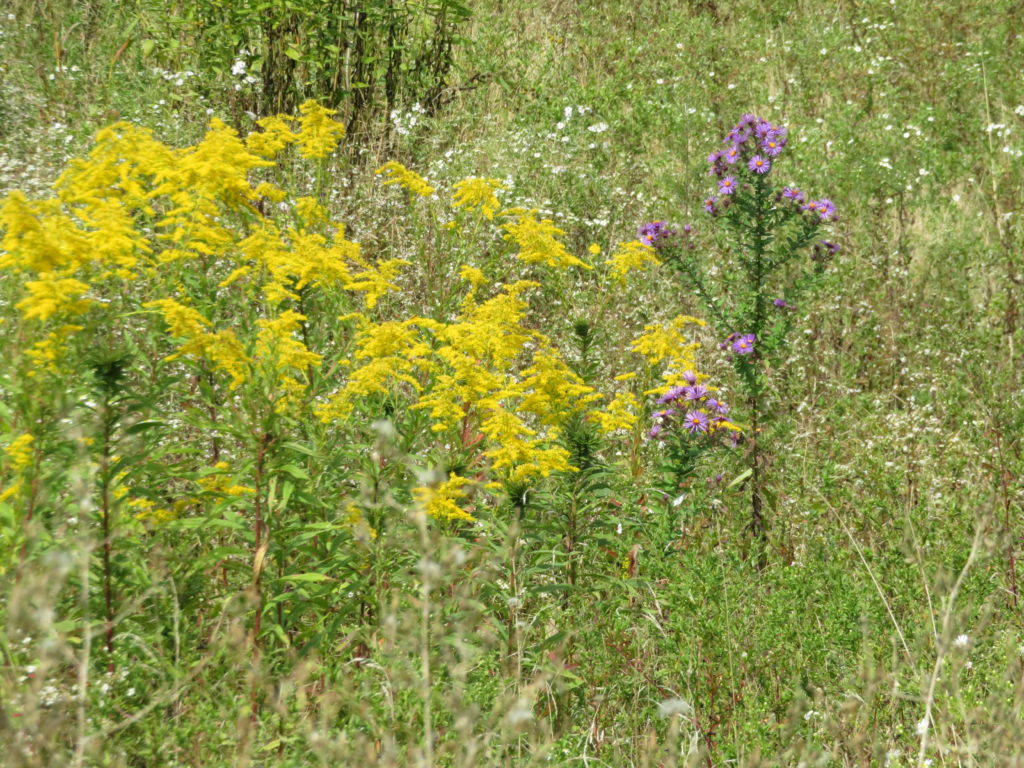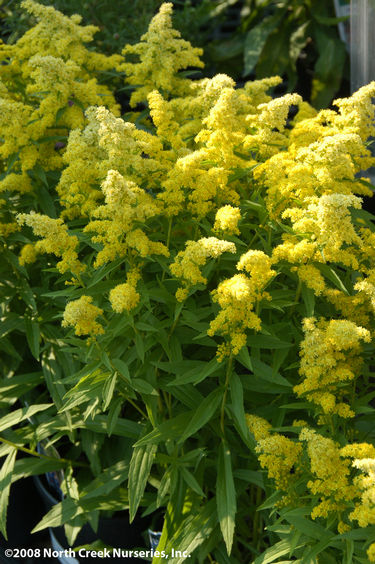Goldenrods (Solidago spp.) represent about 100 species of perennials that grow ubiquitously alongside U.S. roadsides, prairies, open woods, and riverbanks. (USDA hardiness zones 4-9). A few species are also native in South America and Eurasia. Goldenrods are grown for their bright yellow or golden flowers that form late in the summer. They are easy to grow, and the tiny yellow flowers are a bountiful source of nectar for bees and butterflies, including Monarchs; seeds are eaten by songbirds fall and winter.

Goldenrods grow in almost any soil that is well-drained and in full sun. Removing spent flower clusters will encourage more blooms. Deadhead the old spent flowers to avoid prolific self-seeding. Every 3-4 years, divide plants in spring or fall.
Showy goldenrod (Solidago speciosa) is an eye-catching selection with abundant tiny, bright yellow terminal flower clusters atop stiff, narrow-leaved, reddish stems; 2 – 3 feet tall starting in mid- to late-summer.
Wreath goldenrod (Solidago caesia), aka blue stem goldenrod grows 1.5 – 3 feet tall on wiry, arching, glabrous, greenish-purple stems which are covered with a silver-white waxy coating (zones 4-8). Yellow clusters of tiny flowers bloom along the purplish stem in early autumn. Lance-shaped, medium green leaves (2 – 5 inches long) are toothed with sharply pointed tips.
‘Fireworks’ rough-stemmed goldenrod (Solidago rugosa) is probably the most popular variety, this 3 – 4 feet tall clump-forming plant is covered with stiff bright yellow inflorescences in early autumn, reminiscent of exploding fireworks.
‘Golden Fleece’ goldenrod (S. sphacelata ‘Golden Fleece’) grows 18 – 24 inches tall and 24 – 36 inches wide; forms showy sprays of golden yellow flowers from mid-September into October. Its heart-shaped leaves are semi-evergreen.
Ultra-dwarf varieties:
- Little Lemon® (‘Dansolitlem’) – light yellow flowers on ultra-compact plants – 14 inches tall and 18 inches wide.
- ‘Cloth of Gold’ – deep yellow flowers on 18-24 inch tall stems.
- ‘Crown of Rays’ – bright yellow flowers on 2-3 feet tall stems.

No serious insect or disease problems trouble goldenrods and plants are moderately deer tolerant. Spot anthracnose, powdery mildew, rust, fungal spots are occasional problems if summer weather is unusually wet or the planting becomes too crowded.
Goldenrods make colorful companions with excellent additions to a perennial border or meadow favorites such as little bluestems (Schizachyrium scoparium), assorted fall asters (Symphyotrichum), beebalms (Monarda spp.), coneflowers (Echinacea), big bluestems (Andropogon gerardii), Joe Pye (Eupatorium), and Arkansas bluestar (Amsonia hubrichtii).

 Posted in
Posted in 
